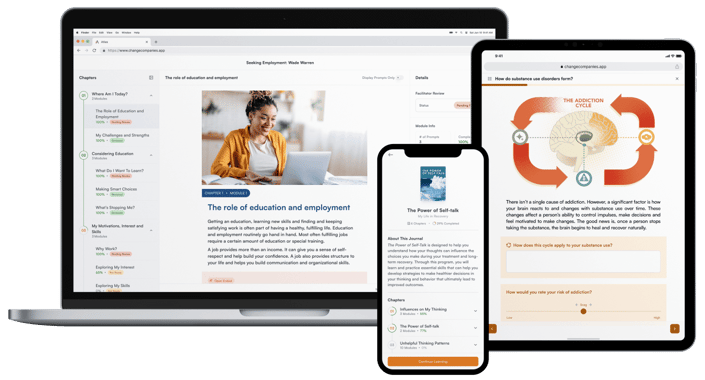Probation and Community Corrections Digital Programming Buyer’s Guide

Digital programming in probation and community corrections is no longer a far-off ideal: it’s both necessary and achievable today. Agency directors face growing pressures such as:
- Increasingly high caseloads and high staff vacancies
- Mandates to increase the dosage of programming and individualize it further
- Unmotivated and disengaged clients who may be less motivated to engage with analog programming resources
- Increased oversight to measure results and demonstrated individualized, well-documented programming planning and case notes
The good news is that digital platforms for community corrections programs are readily available. By embracing proven platforms and strategies, agencies can streamline operations, enhance client engagement, and improve outcomes.
This guide provides guidance for community corrections leadership in developing a digital roadmap for smarter service delivery and staff efficiency: one that sets agencies up for sustainable success.
Key considerations for identifying digital programming platforms
Community corrections leaders may benefit from asking the following questions when identifying the right digital programming platforms:
1. How will this affect my staff?
Digital platforms should protect officer time without sacrificing the quality of services provided, automating processes that are currently done manually.
2. Does it support risk-need-responsivity?
Digital platforms should be designed to be individualized to high-priority criminogenic need areas, and deliver real skill practice versus passive video courses. Engagement for this population is essential for program adherence.
3. Is it accessible?
Digital platforms should be accessible across devices, such as computers and personal mobile phones. The login process should be straightforward for clients, particularly those who may have digital literacy challenges. Literacy and language barriers should also be addressed with accessibility resources within the platform
4. Is it measurable?
The platform should offer streamlined reporting functions that help demonstrate dosage, engagement, completion, and skill application. These reports should be easy to export into case management software and other needed documentation frameworks, and packaged into easy-to-read formats for key stakeholders and funders.
5. Is it secure?
The platform should be HIPAA-aligned and auditable to protect the agency and clients. Real-time alerts should exist to highlight potential client risks, such as harm to self or others.
6. Is it evidence-based?
The platform should be grounded in evidence-based practices such as cognitive-behavioral therapy, motivational interviewing and the stages of change. There should be existing evidence of its efficacy in evaluations, third-party research and case studies.
Recommended features to address these considerations are listed below.
|
Consideration domains |
Digital platform features |
|---|---|
| Staff impact |
|
| Supportive of risk-need- responsivity* |
|
| Accessibility |
|
| Measurability |
|
| Security |
End-to-End Encryption at Every Layer
Zero-Trust Authentication & Federated SSO
Tamper-Evident Event Logging
Defense-in-Depth
|
| Evidence-based |
- Motivational interviewing-informed psychoeducation and reflective questions - Cognitive-behavioral skill-building opportunities - Acknowledgement of the stages of change model to address individuals at varying levels of readiness |
*Important course/curriculum topics to include for a comprehensive risk-need-responsive digital resource:
-
Cognitive-behavioral skill-building/criminal thinking patterns
-
Peer relationships
-
Anger management
-
Substance use education
-
Medication for opioid use disorder (MOUD)
-
Financial literacy
-
Job readiness
-
Parenting/family
-
Emotional self-regulation
-
Trauma education
-
Mental health education
-
Crime-specific resources (e.g., domestic violence, impaired driving)
Discover Atlas
Individualized programming. Measurable results. Delivered digitally.
Learn More About Atlas
Common Pitfalls
While many evidence-based, cognitive-behavioral based tools exist in the community corrections space, there are others that will not pass the litmus test above. These include:
Generic LMS / compliance video libraries
-
Why it’s a miss: LMS course libraries often provide passive content but do not create opportunities for cognitive-behavioral skill practice; further, they do not effectively map risk-need-responsivity domain results onto effective interventions with adequate levels of dosage and duration.
Digitized paperwork (PDF uploads, static forms)
-
Why it’s a miss: Printable worksheets or digitally fillable forms generally lack engagement for clients and provide limited data and insight for staff. Additionally, they are often limited in their ability to enable skill practice, provide adequate psychoeducation, or engage clients at a deeper level.

